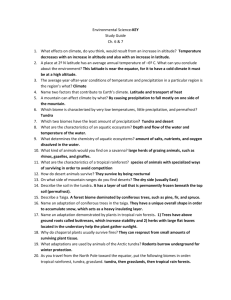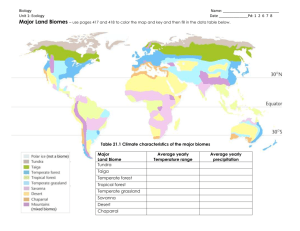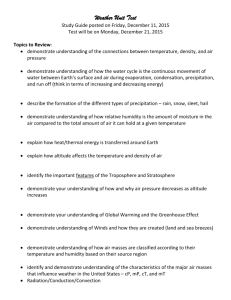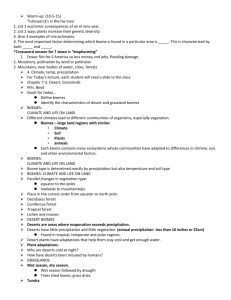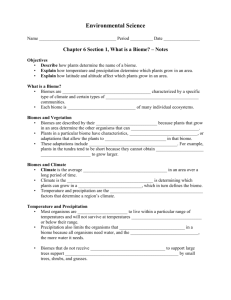Enviro2Go: Biomes
advertisement
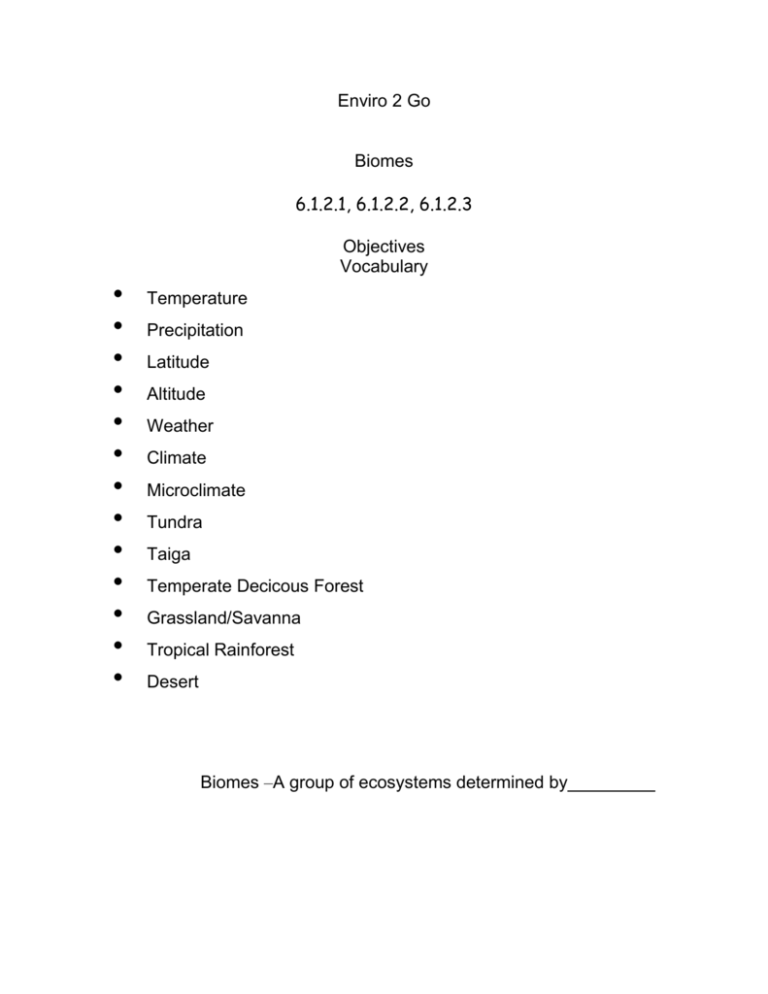
Enviro 2 Go Biomes 6.1.2.1, 6.1.2.2, 6.1.2.3 Objectives Vocabulary • • • • • • • • • • • • • Temperature Precipitation Latitude Altitude Weather Climate Microclimate Tundra Taiga Temperate Decicous Forest Grassland/Savanna Tropical Rainforest Desert Biomes –A group of ecosystems determined by Climate • Climate is the overall occurs in an area over time. and that Factors that affect climate: 1. - which are the horizontal imaginary lines that cover the earth This (differential heating and cooling) also happens on a small scale. causes land and sea breezes. Factors that affect Climate 2. Nearness to a body of a. Large bodies of water tend to temperature Ex. Ocean City, Maryland is usually a few degrees cooler in the summer and a few degrees warmer in the winter. Factors that affect Climate • Wind patterns a. Most weather systems in the U.S. are driven by the wind belt b. Western sides of mountains usually receive more rain due to the rain shadow Factors that affect climate: 4. Mountains a. drops with elevation. Therefore mountainous areas are usually cooler. Biomes • • • • Earth is covered by many types of ecosystems, which are grouped into larger areas known as . Define biome: the major regional groupings of plants and animals observable at a global scale Each biome is made up of many individual How are biomes described? . By their * Plants that grow in an area determine the organisms that can live there. * Plants have particular characteristics, specialized structures, or adaptations that allow the plants to survive in that biome Than the vegetation determines what animals live there! * By the • • Climate is the average a period over time….. and The two most important factors that determine the region’s are the temperature and precipitation. in Testing Yourself Matching ____ 1. Temperature A.Temperature and precipitation over time ____ 2. Precipitation B.Distance north or south of the equator ____ 3. Latitude C.Snow, sleet, rain, or hail ____ 4. Altitude D.Current temperature, precipitation and humidity ____ 5. Weather E.Distance above sea level ____ 6. Climate F.Small area where physical factors alter temperature, precipitation, or humidity ____ 7. Microclimate G.Highest biodiversity on earth ____ 8.Tundra temperatures H. Characterized by evergreen trees and cold ____ 9. Taiga I.Extreme temperature with 4 seasons ____ 10. Temperature Deciduous Forest J.Low precipitation and high temperatures a ____ 11. Tropical rainforest K. Measurement of how hot or cold an are L. Characterized by moss, lichens, and permafrost ____ 12. Desert L. Characterized by moss, lichens, and permafrost Testing Yourself True or False ______1. The distance north or south of the equator is called the latitude. ______2. Climate is the current temperature, precipitation and humidity. ______3. Biome with the highest biodiversity on earth is the taiga. ______4. Latitude is the distance above sea level. ______5. Tundra is an area characterized by evergreen trees and cold temperatures. ______7. Temperate deciduous forest has extreme temperature with 4 seasons. ______8. Biomes are determined by the temperature and precipitation over time. ______9. A small area where physical factors alter temperature, precipitation, or humidity is called microclimate. Testing Yourself Matching Precipitation Tundra Weather Sea Level Taiga Temperature Temperate deciduous forest Tropical rainforest Altitude 1._________ is the current temperature, precipitation and humidity. 2.Biome with the highest biodiversity on earth is the___________. 3.____________ is an area characterized by evergreen trees and cold temperatures. 4.Climate is the _______________ and ______________ over time. 5.The distance north or south of the equator is called the __________ 6.. Altitude is the distance above _______________. 7.____________________has extreme temperatures with 4 seasons. 8.Snow, sleet, rain, or hail are all examples of _______________. 9.__________ is characterized by mosses, lichens, and permafrost. Testing Yourself Short Answer 1.Explain the difference between altitude and latitude. 2.List the biomes in order from equator to pole. 3.How are biomes determined and named ?
